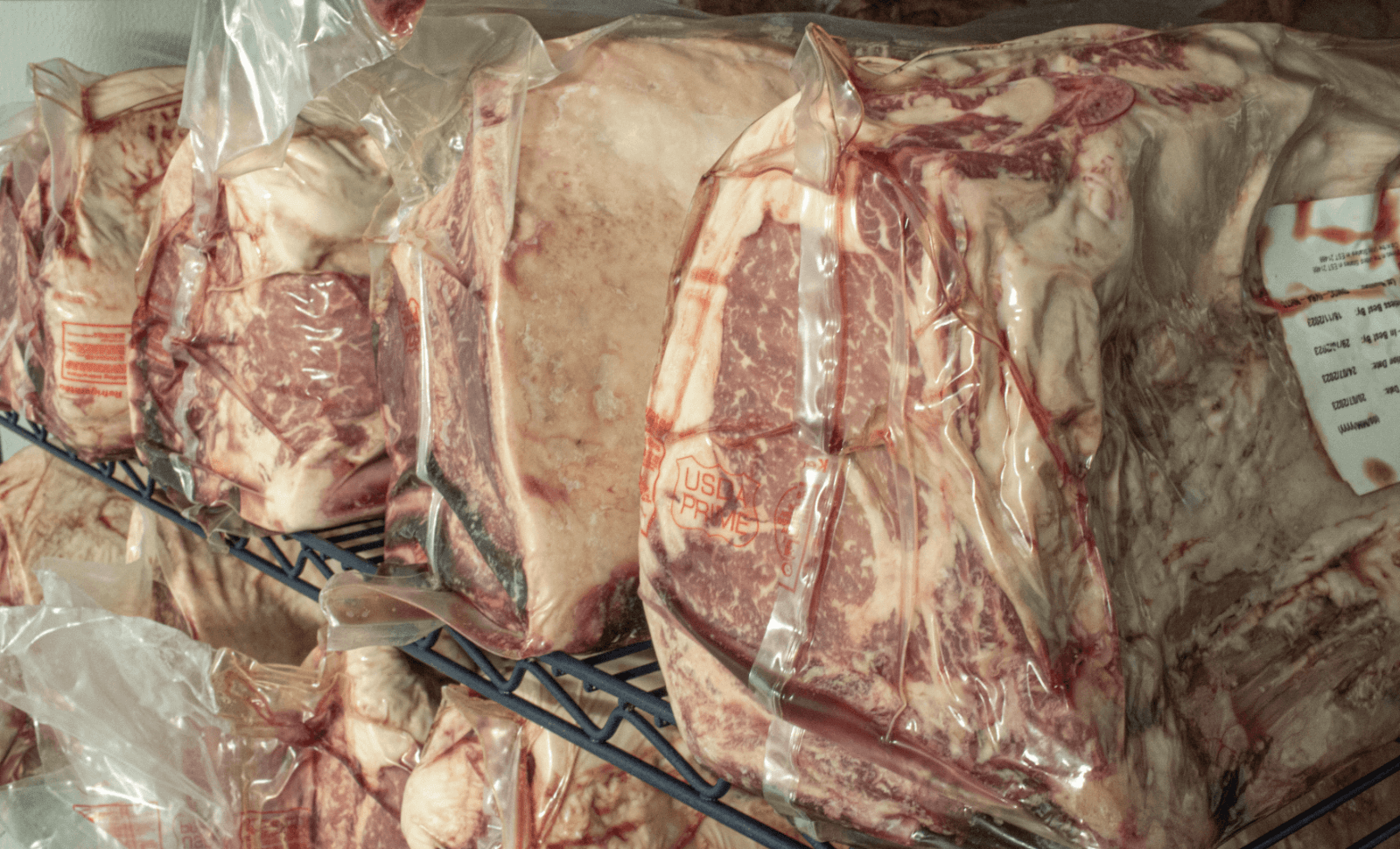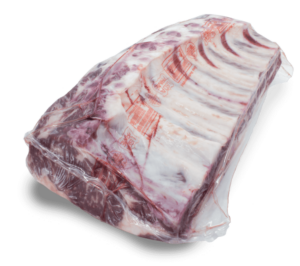

In my grandfather’s age, pretty much everything was dry aged. Whole carcasses would be left to hang in the slaughterhouses for predetermined amounts of time to allow the meat to tenderize and develop more flavor. The practice of Dry Aging fell out of favor as advances in refrigeration and vacuum sealing technology allowed meat packers to safely keep meat packaged for longer periods of time. For us, however, Dry aging beef using proprietary mold remains our sole focus and our specialty. Perhaps in an attempt to maintain some of the cachet of Dry Aging, the industry called this new practice of keeping a vacuum sealed and refrigerated primal: Wet Aging.

Wet Aged Bone-in Rib
The bulk of meat on large scale beef production is all going to be wet aged to some degree. At the slaughterhouses, the packing plants will slaughter the animal, and if they’re going to grade them, they’ll grade the entire carcass Prime, Choice, etc. Then they’ll break down the carcasses into primals (or subprimals), which are just smaller muscle groups, and package each muscle group in vacuum sealed packaging.
How that translates to how we receive the product – let’s say we order 50 cases of boneless ribeyes, we would receive 50 boxes, each box containing 5 individually vacuum sealed boneless ribeye primals. Each case would have the pack date on there, so I would be able to see these were packed on a Tuesday and the truck came to me on a Friday – meaning that they’ve been wet aging for a couple days before I received them. Now if you think of how that works for your Costcos, your Safeways, your supermarkets of the world; by the time the average consumer gets it, you are most likely going to have a wet aged product.
A lot of production plants who sell Wet Aged beef will keep those cases of subprimals in their coolers, for whatever period of time they are wet aging for, be it 20 days, 40 days, etc. What we do is probably different from a lot of plants because it’s a lot more work. We’ll remove each individual subprimal from the cases and put them on racks and let them wet age in our facility on these racks, instead of leaving them in the cases. We do that because one of the risks that you can run into with wet aging is getting a popped bag.
The bag’s vacuum seal can break during transit. It just happens sometimes; nothing’s perfect. But when it does happen, as long as you catch it, it’s not a problem. If you don’t catch it, and that popped bag remains for a longer period of time (several days to several weeks), it becomes a problem because now you’re adding oxygen to the equation. When the vacuum seal breaks, it allows some aerobic bacteria to start breaking down molecular bonds, and in doing so, they produce off-gases. If you ever have a package you forgot in the back of your fridge and it’s blown up like a balloon, that’s the off-gas from the bacteria breaking that muscle down, unable to escape the bag.
To ensure that we aren’t allowing that to happen, each week we’ll go through our racks, and anything that’s popped, we’ll pull and move into the dry aging rotation. We’re opening (removing from the vacuum sealed packaging) so much product on a weekly basis for our dry aging program that we have a home for any popped bags. Because again, if you catch it fast, it’s not an issue. We want to make sure that if we’re sending it out the door wet aged, it has as tight of a seal as possible. If you’re going to wet age, you need to make sure there is zero oxygen in the bag.

Ribeye/Loin muscles from both USDA Select and USDA Choice graded carcasses showed improvement in tenderness after just 7days of wet aging, though interestingly enough the Select product had a slightly higher overall improvement (yet it still proved to be tougher than the Choice, which makes sense because the higher fat content in Choice beef compared to Select is why it presents as more tender and flavorful)
In terms of WHY we want to pay attention to wet aging, there’s a really cool article, “Effects of Postmortem Aging and USDA Quality Grade on Warner Bratzler Shear Force Values of Seventeen Individual Beef Muscles.” It’s good bedtime reading (ha). In the study they did, there is this test, The Warner-Bratzler Shear Force Protocol, that measures how much force it takes for a knife to cut through meat to give you a quantitative value of how tender it is. They test the same cut at various stages of wet aging to prove that, yes, you do get an increase in tenderness as the length of wet aging increases. But what’s interesting is that beef doesn’t get more and more tender every single day. For the longissimus dorsi muscle, which is part of the ribeye and then the loin, you get a remarkable increase in tenderness in the first 10 to 12 days, and then it kind of flatlines. So again, a little bit of wet aging, absolutely, you want to do it. Do you want to go 120 days wet aged? You could have a personal preference for it, sure, but there’s not much research that backs up that you will have a dramatically enhanced tenderness after that period of time, compared to just a few weeks at the front end.
